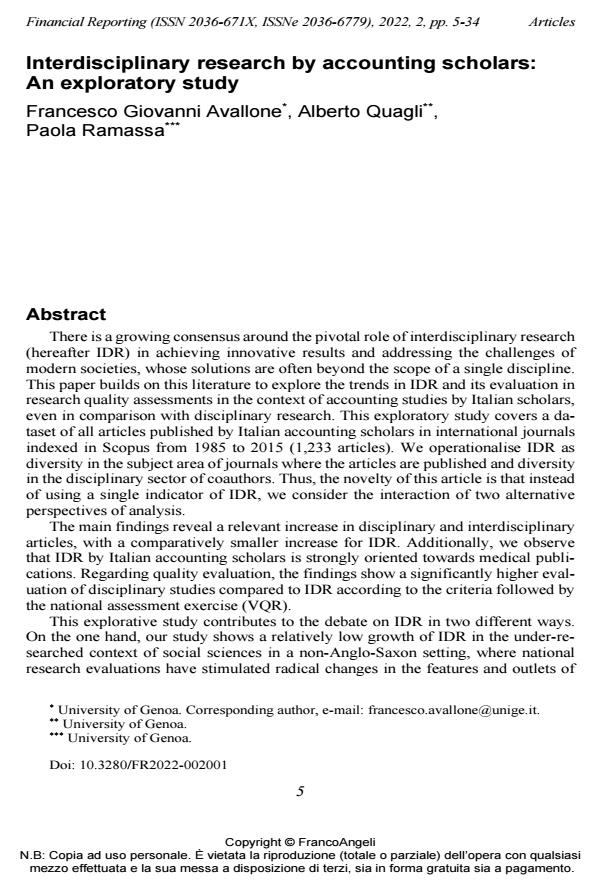Interdisciplinary research by accounting scholars: An exploratory study
Journal title FINANCIAL REPORTING
Author/s Francesco Giovanni Avallone, Alberto Quagli, Paola Ramassa
Publishing Year 2022 Issue 2022/2
Language English Pages 30 P. 5-34 File size 209 KB
DOI 10.3280/FR2022-002001
DOI is like a bar code for intellectual property: to have more infomation
click here
Below, you can see the article first page
If you want to buy this article in PDF format, you can do it, following the instructions to buy download credits

FrancoAngeli is member of Publishers International Linking Association, Inc (PILA), a not-for-profit association which run the CrossRef service enabling links to and from online scholarly content.
There is a growing consensus around the pivotal role of interdisciplinary research (hereafter IDR) in achieving innovative results and addressing the challenges of modern societies, whose solutions are often beyond the scope of a single discipline. This paper builds on this literature to explore the trends in IDR and its evaluation in research quality assessments in the context of accounting studies by Italian scholars, even in comparison with disciplinary research. This exploratory study covers a da- taset of all articles published by Italian accounting scholars in international journals indexed in Scopus from 1985 to 2015 (1,233 articles). We operationalise IDR as diversity in the subject area of journals where the articles are published and diversity in the disciplinary sector of coauthors. Thus, the novelty of this article is that instead of using a single indicator of IDR, we consider the interaction of two alternative perspectives of analysis. The main findings reveal a relevant increase in disciplinary and interdisciplinary articles, with a comparatively smaller increase for IDR. Additionally, we observe that IDR by Italian accounting scholars is strongly oriented towards medical publi- cations. Regarding quality evaluation, the findings show a significantly higher eval- uation of disciplinary studies compared to IDR according to the criteria followed by the national assessment exercise (VQR). This explorative study contributes to the debate on IDR in two different ways. On the one hand, our study shows a relatively low growth of IDR in the under-re- searched context of social sciences in a non-Anglo-Saxon setting, where national research evaluations have stimulated radical changes in the features and outlets of scientific production. On the other hand, our results are consistent with the view that papers with a clear disciplinary focus receive comparatively higher evaluations be- cause the standards established for assessment are usually defined within the disci- pline.
Keywords: interdisciplinary research, interdisciplinary research measure, research quality evaluation, Italian accounting scholars.
Jel codes: M41, I23
- Elections and earnings management: Further evidence from Benford's law Francesco Capalbo, Luca Galati, in FINANCIAL REPORTING 2/2024 pp.105
DOI: 10.3280/FR2024-002005
Francesco Giovanni Avallone, Alberto Quagli, Paola Ramassa, Interdisciplinary research by accounting scholars: An exploratory study in "FINANCIAL REPORTING" 2/2022, pp 5-34, DOI: 10.3280/FR2022-002001